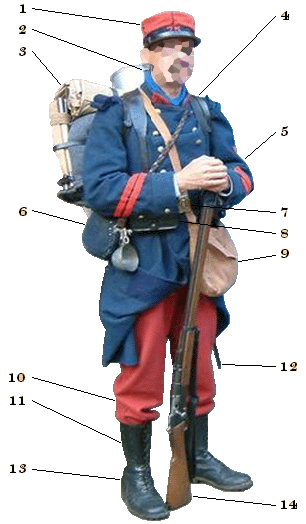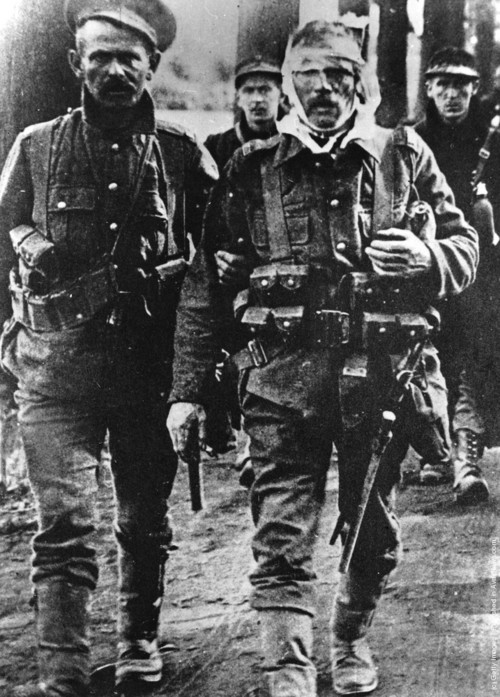Throughout history, the art and craft of war – of using violence in the interest of one’s family, village, clan, tribe, city-state, state, barony, duchy, kingdom or country, has taken one of three, sometimes-interleaving paths.
In some states – mostly smaller ones with little demographic freeboard for such things as specialized militaries, but also nations ranging from Athens, Switzerland, Israel and, in theory and through about 1900 practice in the United States – “defense” was considered part of the freight, along with taxation and jury duty, of belonging to society. The theory was that the citizen militia, fighting to defend home and hearth, would prevail over any invaders – and shouldn’t be called upon to invade.
Yep, they’re Americans. A Philadelphia “Zouave” regiment, patterned after French North African troops that were all the rage in 1861, musters at the beginning of the Civil War, in the American style – muster locally, and then serve the federal government.
In still others – from many a feudal fiefdom through Napoleon’s legions through war machines as diverse as the USA and USSR in World War 2 – the common non-warrior, be he a knave, serf, peasant or citizen – could be expected to be impressed into some form of service as some degree of cannon-fodder or another when the duke, king or Country needed cannon-fodder, on the theory that the citizen/fyrd/serf owes some form of service, up to and including their life, to the state, and the additional theory that having as many people under arms as possible was the best way to ensure victory.

A cartoon lampooning Napoleon’s conscript military. Bonaparte introduced mass conscription, teaching his peasant soldiers the bare rudiments in a tactical doctrine that emphasized speed and brute force, and so conquering most of Europe.
Finally – in some states that developed enough size and wealth to support the specialization, and the philosophy that war was best fought by the professionals, came the idea of the professional caste of warrior elites. These elites stated in legendary antiquity – the Spartan soldier and the Roman Legionary were both long-service elites – and carries forth in the idea of the “volunteer military” that the US, UK and most NATO countries have adopted since the end of the Vietnam and Cold Wars. In between the two extremes, the “armies” of most European monarchies were, to one degree or another, long-serving professional military elites (fear of the repressive power of which led the United States to adopt the “citizen militia” noted above, at least in its early years).

A French infantryman, 1914. By the end of the year, the red was gone – but the blue remained, on the theory that it was a difficult color to see in action. Maybe it worked, maybe it didn’t; the French army retained “horizon bleu” as its standard battledress color until 1940.
The three systems – especially the mass levy and professional military systems – have collided many times over the centuries. But it was 100 years ago this past week that they collided in a way that is still shaking the respective societies involved to this day.
The Industrial Disease: As Europe slid into world war 100 years ago this summer, the Continental powers – in whom the memory of Napoleon was still vivid and only 100 years in the past, and the two largest of which (France and Germany) had fought a mass, industrial war in the living memory of its political class (the Franco-Prussian war of 1871) – had all adopted large, mass armies; French, Austrian and German youth (outside the university class) were inducted for military training and decades of service in the reserves; each nation at the beginning of World War I could mobilize massive armies of reservists; 1.5 million Frenchmen were in uniform when the war kicked off; there were more Germans still. The Russian military was larger still, formed from long-service conscripts (an institution dreaded by the peasantry of the day).

German cavalry on a training exercise, 1912.
The Warriors: Against them, the British Army was a relatively tiny force of seven divisions each of about 15,000 men. With cavalry and support troops, the British Expeditionary Force numbered less than 175,000 men.

BEF troops, lining up for inspection as they land in France, 100 years ago last July
The British Army of 1914 reflected centuries of British hesitancy over large militaries – Parliament still smelled the gunsmoke from the War of the Roses – and more centuries of colonial practice. Britain’s empire was built as much through diplomatic craft, technology and exploitation of human nature as through raw force of arms. It defeated Napoleon as much through its domination of the seas and the enlistment of continental allies as by British infantry’s guts and skill at Waterloo. It conquered India and much of the rest of the world as much by playing coalitions of lesser tribes against larger tribes, neutralizing each other and providing loyal allies to assist the tiny numbers of British troops in maintaining control of places like India, South Africa and, for a time, the United States. When open battle was joined, British technology – the breech-loading rifle and Gatling Gun against the Zulus, the steam frigate against the Algerian pirates – frequently multiplied the meager British forces.
The Few, The Proud: Beyond that? British units had something that’s foreign to most Americans, outside of those who follow the US Marines.
British infantry and cavalry, on enlisting in the military, would join a (usually) local “regiment” – which in the case of the infantry was less a fighting unit than a training depot and a repository of traditions and customs set off, usually, by some distinctive flashes in the unit uniform. A young man joining the infantry in the lowlands east of Glasgow, for example, would join the “Black Watch (42nd Infantry)”, a Scots regiment with several hundred years of history, dozens of battle honors, and a mythology every bit as long and exemplary as that of the US Marine Corps…
…and for exactly the same reason; to imbue in those soldiers an esprit de corps based on a standard of skill and behavior that would guide and inspire them in action.

The Royal Munster Fusiliers. The regiment was recruited in what is now the Irish Republic, and after WWI the unit became part of the Army of the Irish Republic – although the Irish disbanded the regiment by 1920. The Munster Fusiliers were heroes at the the Marne, and were reduced to a shadow of their former strength at Ypres and the Somme.
And just as it does with the USMC, it did (and to this day does) the same for the British soldier.
And at no time was that esprit de corps more firmly entrenched than with the British Army in 1914.
The Army was tiny by later standards – but every man among them was a volunteer, a long-service “regular” (backed by a “Territorial Army” of part-time soldiers that was a bit like our modern Army Reserve) who took immense pride in his skill at arms.

The Scots Guards leaving the Tower of London en route to France
And in none of those units did the Corps have more De Esprit than the Guards Regiments. These men were screened not only for physical aptitude as infantrymen, but were all over six feet tall (so as to make the most imposing appearance on guard duty) and other martial virtues. And in a day and age when ammunition was dirt cheap, they spent time on the rifle range that would dazzle even modern American soldiers, honing their marksmanship to a sheen not seen in any mass military before or since.
100 years ago last week, the cream of the Army – the BEF – had been held as a reserve as the French and German armies duked it out across Belgium and northern France, waiting for the situation to develop as the two belligerents met on August 22 in the Battle of the Frontier, the bloodiest single day of the war (yes, bloodier than any single day at the Somme, Verdun or Ypres). The Frontiers battle ended in the French Army being stretched to breaking point (and the Belgians beyond theirs), with the Germans closing in in Paris. And so the high command committed the BEF to the line at the First Battle of Mons.

BEF machine gunners at the Oise River, in the opening weeks of the war.
And at Mons the mass German force ran – over open terrain, toward shallow foxholes and ditches dug by the Brits – smack into all of that highly-trained rifle fire. The British regulars scourged the German attacks, brutalizing them with rapid, accurate rifle fire so heavy that the German infantry thought they faced massed machine guns. Far from it – the British issued two machine guns per battalion of 700 men, in the first year of the war. It was British “tommies”, their skill with their bolt-action Lee Enfields such that they could work the bolts on their well-worn pieces with their thumbs without taking their fingers from their triggers, achieving rates of fire almost equal to the semi-automatic rifles the British infantryman wouldn’t get until the late 1950s, and accuracy that’d make a Navy SEAL cock an eyebrow from respect.
And the German Army – the mass of over a million draftees, recalled from the farms and factories and given rifles – battered itself half to death against the BEF’s line. It was a scene of carnage that may have partially inspired Tolkein’s depiction of Elf fighting Orc at Helm’s Deep…
…including in its denouement. Mons led to the First Battle of the Marne, the German high-water mark. Then Le Cateau, and the Battle of the Aisne, where for the first time the side started digging trenches. And then the First Battle of Ypres, in Belgium. All between the third week of August and the beginning of October.

British and Belgian “walking wounded” at Mons.
And the constant attacks, and endless fighting, wore the BEF, perhaps the most elite mass army ever sent to war, down to a shadow of its former self.
The British Army had to resort to casting ever-wider nets for volunteers – eventually recruiting the “New Model Army” in time for the Somme in 1916, by which time the last of the veterans of the BEF were salted away as senior NCOs, a thin film of survivors leading a mass army of newbies and, after the bloodbath of the Somme and Second Ypres, the unthinkable; draftees.
It was the wearing down of the elite of the BEF that led, eventually, to the draft – an immense leap forward in government power over the individual that, in many ways, opened the way (in Britain as it would in the US) for further government intervention in the life of the individual even as the Great War was eating away at the barriers between the public and private sectors in the UK.
And 25 years later, when British troops went to war again, they jumped immediately to the draft, and to the mass levies that characterized, for the first time in human history, modern industrial warfare.
Just as would the US.

Pingback: The Somme, Part I: The Accrington Pals | Shot in the Dark
Pingback: The Somme, Part II: The First Day | Shot in the Dark